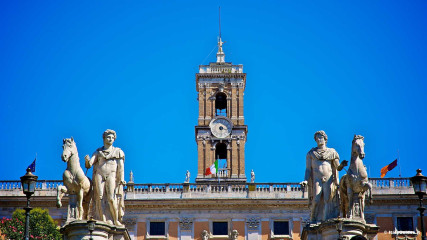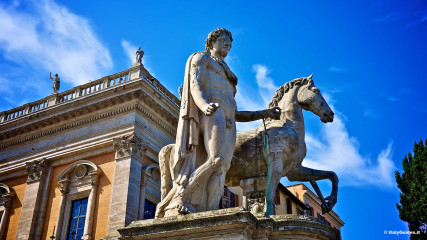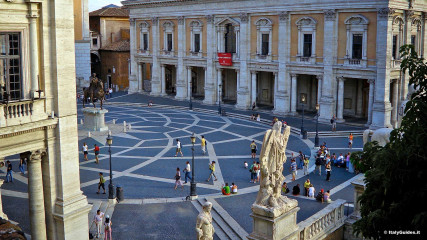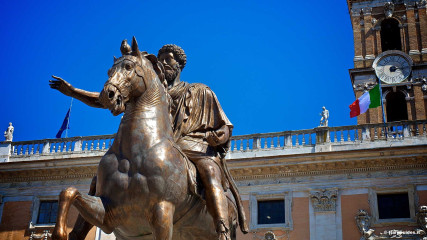When Emperor Charles V visited Rome in 1536, Pope Paul III Farnese was so embarrased by the muddy state of the Capitol that he asked Michelangelo to draw up plans for repaving the piazza, and for renovating the façades of the Palazzo dei Conservatori and Palazzo Senatorio.
Michelangelo proposed adding the Palazzo Nuovo to form a piazza in the shape of a trapezium, embellished with Classical sculptures chosen for their relevance to Rome. Building started in 1546 but progressed so slowly that Michelangelo only lived to oversee the double flight of steps at the entrance of Palazzo Senatorio.
The piazza was completed in the 17th century, the design remaining largely faithful to the original. Pilasters two storeys high and balustrades interspersed with statues link the buildings thematically.
The piazza faces west towards St Peter's, the Christian equivalent of the Capitol. At its centre stands a replica of a statue of Marcus Aurelius. The Original is in the Palazzo Nuovo.
As you walk up this stairway, you have the sensation of a space that opens before you, with its most important building, that of the Senate, visible all the way from the bottom of the ramp.
The result is true set design but the real star of the piazza is the magnificent pavement, designed by Michelangelo but built 400 years later during the 19th century.
The monumental motif is a central star created from interwoven elipses that form a sort of spiderweb that manages to interconnect the three buildings in a single, harmonious whole.
Statue of Marcus Aurelius
At the center of the piazza, Michelangelo built the base for a precious work of art from the Roman era: an equestrian statue of Marcus Aurelius. That which you see in the piazza today is a copy, the original is safely tucked away inside the Capitoline Musems.
The statue was the cause of two famous misunderstandings: it’s one of the very few works in bronze that survived the Middle Ages, an era when ancient statues were melted down and their metal reused; this was because the popes, owners of the statue up to the 15th century, thought that it was of Constantine, the first Christian emperor, and thus spared it.
The second misunderstanding is tied to a legend according to which the cry of the small owl sitting between the ears of the horse is supposed to announce the end of the world. Fortunately, the event seems rather improbable since the supposed owl is actually only a tuft of hair in the horses mane!













